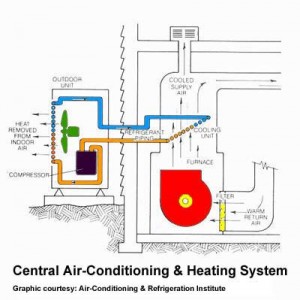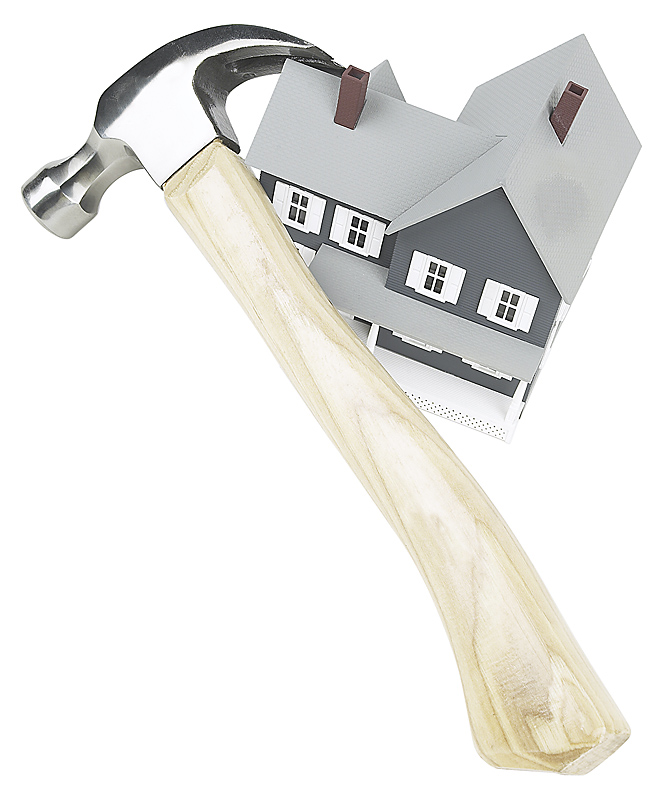When the thermometer hits the triple digits, you better know how to keep your AC unit happy
By John D’Annunzio, Columnist, UnionvilleTimes.com
 In this edition I will talk about three subjects, how air conditioning systems work, how to maintain them and saving tips on electricity.
In this edition I will talk about three subjects, how air conditioning systems work, how to maintain them and saving tips on electricity.
Air conditioners have several parts; the unit outside of a building is called the condenser or compressor. The refrigerant in the system, usually R410-A, is a gas but, when traveling through the compressor it squeezes the fluid, which packs the molecules of the fluid gas closer together causing a higher temperature and high energy.
Once out of the compressor it travels into the condenser as a hot high pressure gas. The condenser is part of the unit that has fins or a radiator all around the unit outside. Now the spinning fan in the outside unit draws the heat out of the fins of the condenser to cool the gases down. Somebody may ask how the hot gas gets cooled.
The gases are a couple hundred degrees hotter than the atmospheric temperature , what the fan does is draw whatever temperature is outside, say 90 degrees, through the condenser coils (radiator). Since 90 degrees is less then the hot gasses it is cooled as a liquid. The liquid gas goes into the evaporator.
Now lets go to the inside unit, the HVAC unit, that gives you heat in the winter and cold air in the summer. The evaporator inside the unit holds the cold refrigerant. There is a large fan with horizontal blades which circulates the warm air inside your house across the evaporator coils—remember the coils are cold at this time. It’s like having a block of ice in front of a large fan. So the fan at this time is blowing cold heavy air into the supply plenum which connects to all the duct work in your home.
Maintenance:
Before performing maintenance on anything consult your owner’s manual. If you don’t feel comfortable, check with a qualified technician to do the work.
First, the outside unit, the compressor, can be turned off by the disconnect switch usually mounted on the building wall. If you can remove the steel grill cover attached to the fan, cover the motor with some kind of plastic.
Wash the condenser fins from the inside out, any debris lodged in the fins hinders the cooling process and will cause the fan motor to work harder, hence more electricity.
Now while the motor is exposed check your owner’s manual to see what type of fan motor you have. Some require a couple of drops or thin oil, then again most are maintenance-free no oiling necessary. Next see if the entire unit is level, you don’t want a fan blade out of balance this stresses the bushings or bearings in the motor. The mechanical code requires the unit be elevated 6” from ground level; this is to keep snow, weeds, etc. from blocking the condenser.
Now the inside unit, the air filter is usually located on the return duct against the unit. Go by the manufacturer’s instructions on when to change this. If you have someone who smokes or have animals you should change the filter once a month. Some of the problems that occur with a clogged filter include a motor working very hard due to the negative pressure build up.
I was building a house last year and a woman across the street said she smelled smoke in her basement. What I saw was an electric HVAC unit (non-gas) in a closet-like space with a closed door and part of the carpet from the adjacent room was closing the bottom of the door off from any air. Where the return air duct was connected to the plenum of the unit, duct tape sealing off the unit’s plenum was pealing off the plenum and the duct work causing an air space.
When this happens in a concealed space with little to no air the unit’s fan draws all the air out of the space through the leaky seal causing a negative pressure, which can cause a fire due to the motor overheating. One test you can do in a situation as above is hold the door open about 2”. If it draws closed then you need to check to see if all of the connections are tight.
Also if you notice accumulated dust around the compartment’s doorstops, this means that the unit is being choked off. So it wouldn’t hurt to put in a louver door or a return register grill somewhere around the compartment area. Even if there isn’t a problem, a little air helps dissipate any heat around the unit.
Now with a gas unit in an enclosed space it may be a different story. An important step to consider is the condensate water dripping from the evaporator coils on the inside unit.
Make sure the water is draining properly: you don’t want any stagnant water to remain behind. Stagnant water means that mold and odors that can circulate through the duct work.
Make sure that the condensate pump is working. The condensate can be pumped outside or to an approved drain inside. According to the International Plumbing Code, if pumped in the sanitary system of your house, it is then considered indirect waste which requires an air brake set up (keeping the condensate hose elevated inside the trap).
Energy Saving Tips
Make sure all openings to the building are weather tight. Also fireplace openings should be covered with ornamental fire proof glass or other safe means. The damper should be closed.
Set the thermostat higher during the time the building is not occupied
Shading on windows is a must
Keep heat-producing appliances away from a thermostat.
Use fans when possible.
The best thing is to buy Energy Star rated appliances that have built in energy-saving devices.
John D’Annunzio is a local Commercial and Residential builder who has held nearly every job in the construction industry from heavy equipment operator to home builder. He is ICC building code certified and lives and operates in Chester County, PA. His column will appear weekly and address various home improvement and building issues with special attention to subjects of interest locally.
Contact John at johnd3656@verizon.net









Trackbacks